
I’m sure most people are familiar with a to-do list. If you’ve been reading this blog for any length of time, hopefully you have at least one of these on the go, tracking your tasks on paper. But do you have a to-learn list? I recently decided my self-education system needed a bit of cleaning, so creating a to-learn list seemed like a natural result.
If you’re reading a few books a month, you’re already way ahead of most people. But just because you feel you’re doing better than average doesn’t justify a poorly organized approach to teaching yourself. I’ve set up a to-learn list as a way to ensure that the best books are at the top of my stack, not just the ones with the most current hype.
Benefits of a To-Learn List
I’ve just started with this to-learn list but already some of the benefits I see:
- Focus on great ideas versus the most popular ones. It’s easy to buy books only from the front of a bookstore. Saving your ideas can get you to push into different subjects that might take more searching.
- Split up your interests. If your self-education isn’t organized, it is easy to pick your favorite subjects even if 90% of the book’s material is old. Keeping a to-learn list allows you to explore subjects that are on the fringe of your current understanding.
- Create a more varied reading diet. Keeping a to-learn list can help you balance fiction with non-fiction, science with literature and blend different types of books so your reading list doesn’t get stale.
To-Learn Versus To-Do
A to-learn list can’t work the same as a to-do list for a number of reasons. The biggest is simply that a to-do list typically involves things that must be done. Going to work, cleaning your house and picking up the dry cleaning are all necessary. In theory at least, each to-do item you check off means one less to do.
Not so with a to-learn list. Each book you learn opens up the possibility for more learning. If you make a typical checklist format for your to-learn, then it could easily explode in size far faster than you could ever read.
Instead of a checklist, my to-learn list has two parts. The first is a huge brainstorm where I’ve written down everything I want to read and learn from Shakespeare to cognitive psychology, martial arts to being fluent in Hindi. This entire pool of ideas is unmanageable as a list, but it gives me a solid base to work from the next time I need to get more books.
The second part is a stack of about 5-7 ideas I want to chew through next. This is a little over a months worth of reading, and about the size I would need to take from the library or bookstore.
Bookmark It!
Whenever I get an idea for a subject I’d like to learn more about or an author I haven’t read yet, I write down those ideas on my notepad. I can then add this to my to-learn pool for more ideas of books I could read in the future.
To-Read Versus To-Learn
A to-read list is a good idea, but it only encompasses one form of self-education. Keeping a to-learn list means you also need to add in subjects and ideas that you can’t get from a book. Cooking, martial arts and foreign languages can’t be grabbed entirely off the page.


 I'm a Wall Street Journal bestselling author, podcast host, computer programmer and an avid reader. Since 2006, I've published weekly essays on this website to help people like you learn and think better. My work has been featured in The New York Times, BBC, TEDx, Pocket, Business Insider and more. I don't promise I have all the answers, just a place to start.
I'm a Wall Street Journal bestselling author, podcast host, computer programmer and an avid reader. Since 2006, I've published weekly essays on this website to help people like you learn and think better. My work has been featured in The New York Times, BBC, TEDx, Pocket, Business Insider and more. I don't promise I have all the answers, just a place to start.